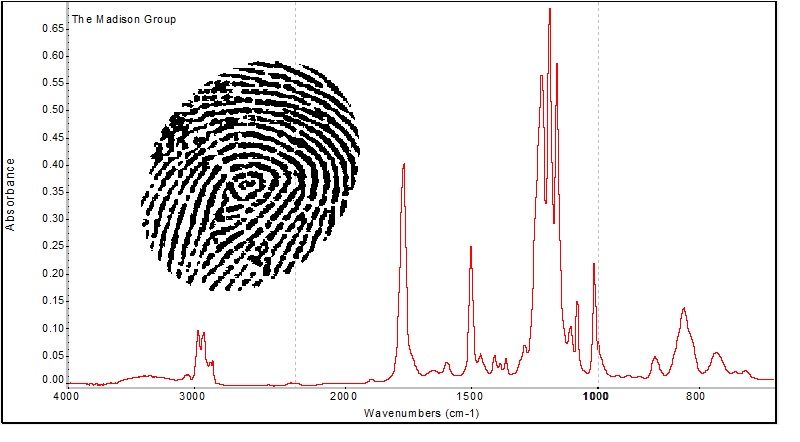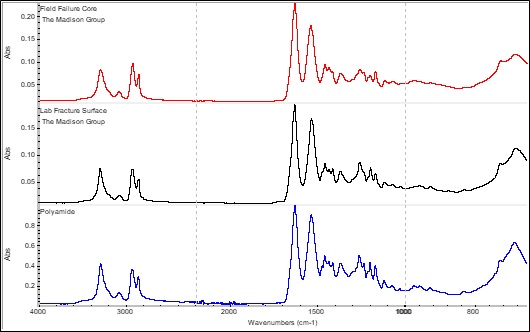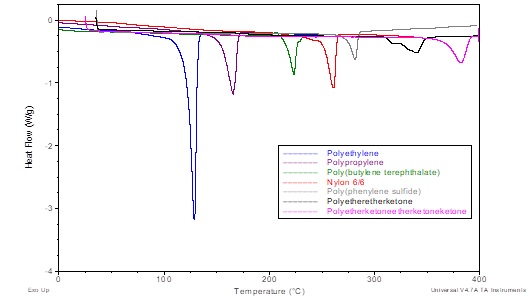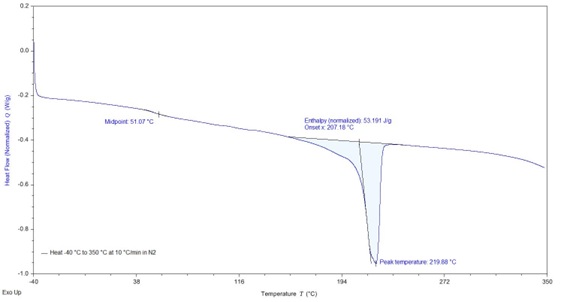Whether you are a designer, manufacturer, or end user of polymeric products, the question is often asked what is or should my polymeric component be made from. These thoughts can be founded from an honest curiosity about what material is in a product, necessity during a part design cycle, or in the worst-case scenario, a product failure. While these three reasons for asking the question have the same goal in mind, they are completely different in the level of detail required, and the techniques used to achieve the end goals. This leads to different tiers of material characterization that are dependent upon the specificity required. In my experience, there are three different tiers of characterization that our customers require to move their project forward. In this series of articles, we will be analyzing the intricacies of each tier of characterization and the expected results from each.
Tier I

Figure 1 – FTIR analysis is like a chemical fingerprint that can be used for identification of polymeric materials.
The first tier of characterization is for the person who is looking to identify the basic polymer family that is utilized in a product. In this situation, we are trying to detect if the part is made from polyethylene, polypropylene, polyamide, or any other multitude of materials. Customers that are asking for this level of resolution are typically doing so to investigate contamination of a part or get the ball rolling on a project with the intention of a more involved analysis or research and development, further down the road.
The first tier of material characterization requires, as would be expected, less testing to achieve. However, with the large diversity of polymeric and elastomeric materials in existence, the techniques required still vary. Let us look at some of the most common techniques that are required to achieve the first tier of characterization.

Figure 2 – FTIR analysis shows the material family of samples, such as this polyamide resin shown above. It does not provide the specific type of polyamide. This would require additional testing to determine.
Most material analyses start with a technique called Fourier transform infrared spectroscopy (FTIR). This technique provides an analyst with a graph that contains peaks and valleys that are created by the vibration of the chemical bonds in the material. This graph is akin to a human fingerprint and provides a graphical representation of the bonds within a material that can be used for identification, Figure 1. With this technique, we can differentiate the base polymer and identify the most basic characteristics of the material. It is important to note that while this test can provide families of material (polyethylene, polyoxymethylene, etc.) there are many nuances within these groups of resins that are not fully resolved with just one test. For example, if the base polymer is a polyamide, FTIR alone cannot tell us if it is a polyamide 6, (6,6), (6/12), etc., Figure 2. Since these subgroups within a material family can be so diverse, the first level of characterization typically will utilize another technique to further identify the material.

Figure 3 – DSC analysis showing the differences in melting temperature of various semi-crystalline materials.
The second test method to obtain a Tier I characterization is typically differential scanning calorimetry (DSC). This analysis technique subjects the material to heat at a known rate and measures the change in heat flow for identification. The results provide information on the glass transition temperature and the melting temperature, which helps an analyst determine material characteristics such as if it is a blend, homopolymer/ copolymer, or the specific subset within a polymer family, Figure 3. A good example of the necessity of this technique is polyamide materials, which have many designations such as polyamide (6), (6,6), (12) and several others, Figure 4. These designations identify the chemical structure, which plays a larger role in the physical and thermal properties. Additionally, identifying this sub-group is important to distinguish your material from the copious possibilities within the polyamide family.

Figure 4 – DSC results from the material in Figure 2, showing a glass transition and melting temperature characteristic of polyamide 6.
The information provided from a Tier I analysis is extremely useful to understand the type of material used. This will give some basic information on expected thermal behavior and general ideas of performance based on the polymer morphology. Further, this level of characterization will aid to pinpoint the source of contamination. However, this basic information will not allow the end user to design a component for performance or understand how the material will process during manufacturing. To get more information that will help to compare to data sheet values for performance, we need to move to a Tier 2 analysis. This stage will look further into the material composition, molecular weight, and some of the major additives within the material. This will allow for a more detailed review of datasheets and expected properties of the material in your design.
Check out Polymer Material Characterization Tier 2 and Tier 3.
